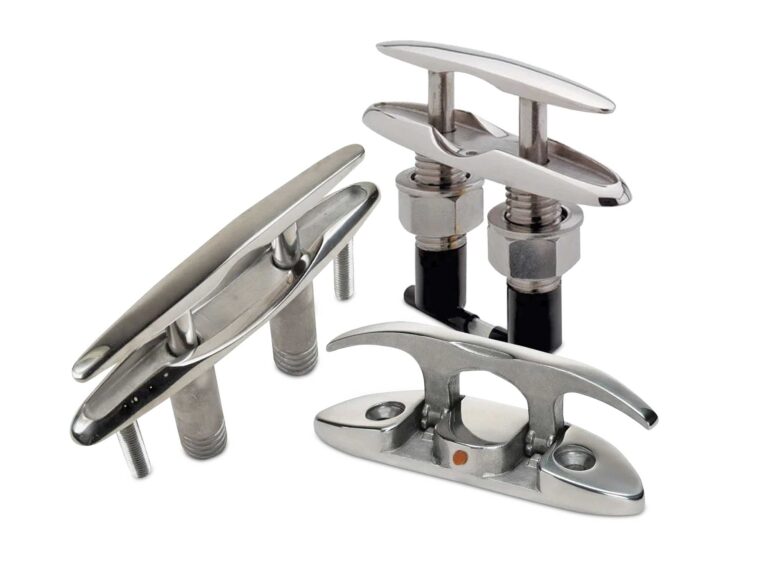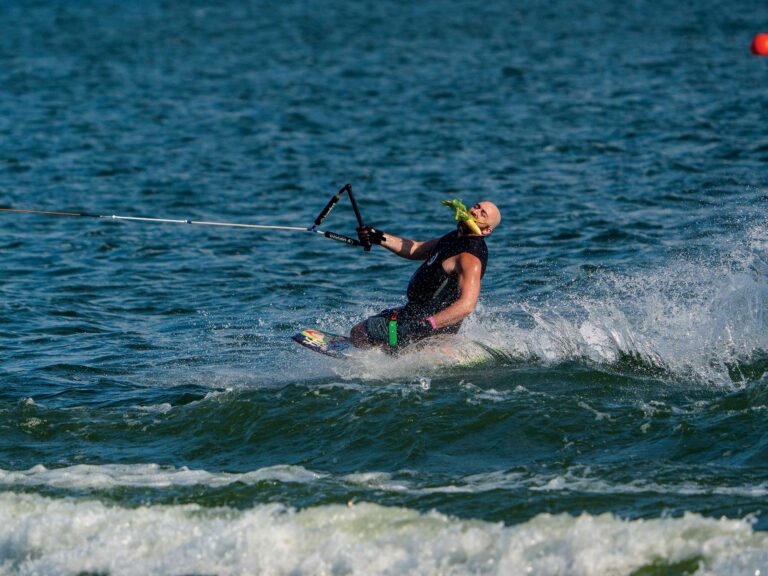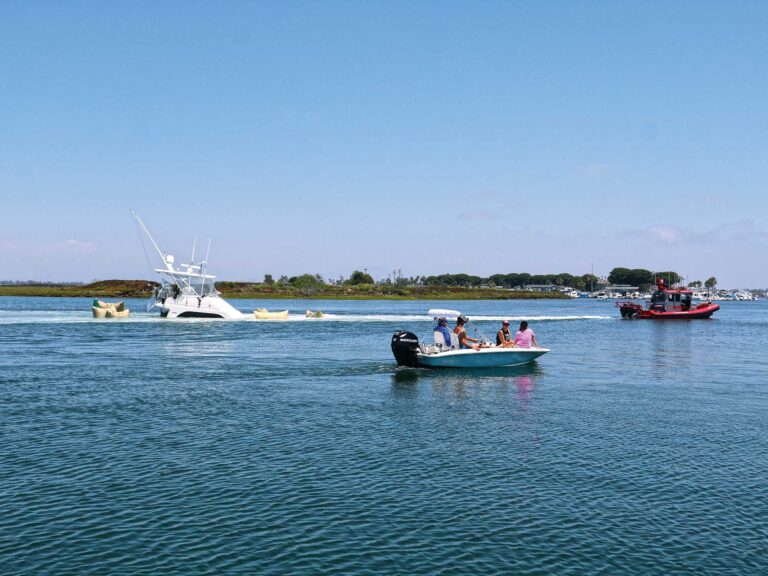Speed is intoxicating. It’s visceral. A kind of thrill that appeals to your senses at the most primitive level. Once you’ve experienced it, there’s no turning back. Like any other rush, it’s a fix you want again…and again…and again.
No problem. Except speed doesn’t come cheap. Especially on the water. To put yourself into the magic 70-mph-plus echelon, expect to pay about $100,000 for a 26′ single-engine offshore-style go-fast. That’s about $1,429 for every mile per hour you want to fly. Is high price the necessary consequence of high performance? Maybe. Then again, maybe not.
If the boat has to be big, be prepared to pay big. But if you’re a true velocity junkie, if the gut-level thrill of speed is simply the result of how fast you can rocket across the water – and you don’t care how you get there – we have your ticket to ride. You’ll not only go fast, you’ll feel as if you’re approaching Mach 1. Plus, accelerating to that top speed will be like driving a nitro dragster, leaving you with a wind-stretched grin for the few seconds it takes for the speedometer to register those magic digits of 70…and beyond. The best part is that you get all this for the price of a blue-light special. How does paying only around $170 for each mph sound to you?
Want speed for less? Here’s the ultimate bang for the buck.
The Price of Speed
The boat that does all this is one you sit on, not in. It’s a waterbike. The one we’ll work with is Sea-Doo’s popular two-passenger RXP. However, there are plenty of other bikes capable of hitting our target with the most minimal of investments.
At the RXP’s heart is a 1,494 cc four-stroke, single overhead cam engine with four valves per cylinder and multiport fuel injection. It produces an impressive 215 hp, much of which is the result of a centrifugal supercharger with intercooler. In stock form, it runs reliably in the 67-to-69-mph range with a light load. Right out of the box you’re already scratching the underside of 70.
But I intend to build upon these stock credentials by turning to the premier waterbike performance shop in the nation, Riva Motorsports in Pompano Beach, Florida (877/748-2926). Several years ago, Riva powered a Yamaha GP-1200R WaveRunner into the Guinness record books with a speed of 87.5 mph. The company claims to have pushed waterbikes into the 90-mph range. But rather than opt for its vaunted custom-tuning expertise, I’ll keep things simple by installing one of its inexpensive Stage I performance kits. With it, Riva promises to push my $11,199 2007 RXP beyond the 70-mph mark for the bargain-basement price of $674. Boat and mods combined, that’s about one-tenth the cost of a 70-mph offshore go-fast.
To my surprise, the components required to push the RXP this fast are relatively straightforward and require little more than a few hours of labor and an upgraded diet of 91-octane gas.
One of the biggest boosts comes from Riva’s Power Filter, an air intake system that replaces the more restrictive stock intake. Essentially, it’s a 3″-diameter J-shaped duct capped with an oversize K&N filter. The Power Filter is supposed to improve acceleration and raise rpm by feeding the supercharger a healthy supply of cool air.
The remaining mods will be done at the craft’s pump. A thin two-degree wedge will be placed between the pump stator and the output nozzle to trim up the nozzle, raising the bow of the craft while underway to reduce drag. I’ll also be swapping out the stock impeller for an aftermarket Solas model pitched specifically for this application. The final component is Riva’s top-loader intake grate. This grate protects the pump from debris and adds a reverse wing to more effectively load the craft’s pump, a design modification that is said to eliminate most prop spin and cavitation.
All together, Riva owner Dave Bamdas claims this package will put me close to 72 mph. A tall order? Let’s find out.
** PUCKER POWER**
I start the day by establishing some baseline numbers for our project craft, a waterbike that in its stock form will thrill even the most jaded speed freak. On this relatively calm, 72-degree Florida morning, the RXP proves strong, setting a 69.14-mph baseline. It also impresses me with its 1.72-second acceleration from 0 to 30 mph. A $100,000 offshore go-fast could take up to 12 seconds to do the same.
It’s this rocket-like acceleration that instantly separates a waterbike from most speedboats. Only inches removed from the water and straddling a craft that’s barely 4′ wide, I experience a rush of speed I’ve never felt inside a cockpit. It’s an arm-wrenching, sphincter-puckering surge that happens so quickly, it takes a few seconds for my brain to catch up. It’s so sudden that without the proper stance, the rush forward could be hard to control. Before launching, I have to stand with my feet braced firmly in the craft’s footwells and lean most of my body over the handlebars. This helps keep the bow planted as the craft pulls hard. Otherwise, it would simply leap out of the hole and leave me in its wake. Once on plane, I ease back into a crouch, in contact with the seat but with most of my weight supported by my legs. At top end, the speed pulls tears from my eyes and flaps my cheeks as if I were in a hurricane.
Impressive? Sure. But I’m looking to hand a go-fast its lunch. So it’s time to get dirty.
Back on land, the switch to Riva’s Stage I components goes relatively smoothly. The primary challenge is wrestling the lengthy stock intake ducting out of the waterbike’s snug engine compartment. It’s easier if you remove the engine compartment cowling – just make sure to tape the exposed fiberglass edges or you’ll get some nasty cuts.
It’s a cumbersome job, but by removing the stock piece in sections, I get it done, albeit with the help of a few four-letter words. Part of the stock unit I pull out through the bow’s stowage hatch. The remainder I ease out via the engine compartment. Installing Riva’s replacement part is far easier. I slide in this shorter piece using a sweeping motion, then fasten the ends in place, one at the supercharger, the other at the front of the engine. Riva’s instructions are clear and detailed, but there’s tech support available by phone if you need it.
The remaining parts require removing the pump and switching out the stock impeller. Everything else is accomplished with basic hand tools, but the impeller requires a special $31 tool from Sea-Doo. The pump wedge is installed as I reassemble the pump. A swap out of the stock intake grate, a little silicone sealant, and I’m done. Time on the clock: 4 hours, 5 minutes. According to Bamdas, Riva techs would do the work for me in three hours for about $300, plus another hour of labor for water testing. I think most moderately skilled owners could easily handle the job.
BURDEN OF PROOF
Back on the water, I reacquaint myself with the newly kitted RXP. From a pure seat-of-the-pants perspective, the performance gains are felt mostly on the top end. To verify this I set up for a radar run. I idle into position, then punch the throttle, summoning all of the RXP’s power as I rocket across the lake on a series of back-to-back runs. A check of the computer confirms my intuition. I hit an average top speed of 71.9 mph, nearly a 3-mph gain, yet only slightly improved on the stocker’s already strong acceleration, going from 0 to 30 mph in 1.65 seconds, a gain of o.o7 seconds.
Had that hypothetical go-fast been next to me at the start I would have handily beaten it off the line, then slowly increased my lead as we sped across the lake. I’m impressed.
Purely for grins, I meet up with the Riva techs at the company’s test lake and take the throttle behind two of the company’s higher-end packages – one with a Stage II kit, the other tweaked to kill with a Stage III. These modifications aren’t as simple to install as my Stage I, although they’re still relatively inexpensive. However, Riva doesn’t recommend them for recreational use, billing them for “competition” only. You also need to be a fair mechanic to do the installations.
The Stage II kit costs around $2,900. It contains the workings of the Stage I package and adds such items as a new supercharger impeller and oversize intercooler. Riva’s Power Cooler claims to deliver a 15-hp increase in peak power, while lowering exit temperatures an average of 50 degrees. Cooler air equals better power, and this is the big-ticket item on the list, costing nearly $1,300. Other mods include a rear exhaust kit, which reduces backpressure and restriction in the exhaust but does away with the stock sound suppression system. Performance types might love the throaty growl, but your neighbors will likely feel otherwise. Still, it’s a lot quieter than the average go-fast running an open exhaust. Other components affect handling, including the removal of the stock off-throttle steering system as well as the addition of performance sponsons.
A Stage III kit costs a bit more than $6,300. This kit includes most of the components of the Stage I and II kits, as well as a Riva Pro Series ECU, which alters the fuel delivery, timing, and rev limiter to match this now highly tuned engine. Other mods include new fuel injectors, thermostat, impeller, and even pricy titanium valve spring retainers.
Against the gun, the Stage II package ups the ante yet again, peaking at 75.4 mph while lowering my acceleration time to 1.62 seconds. Aboard the Stage III rocket ship, I hit 80.1 mph, reaching 30 mph in only 1.41 seconds-I’m grinning like a madman. Eighty-plus on a craft that weighs less than 800 pounds isn’t for the fainthearted, nor the recreational driver. Still, I’m shocked by how stable and comfortable I feel in the saddle. I’m also looking around for the nearest sucker with a go-fast. ****
THRILL-O-METER
The verdict? For cheap speed, nothing surpasses a waterbike. Certainly much of it is due to the craft’s natural thrill potential. Being so close to the water lets you feel every one of those 70 miles you’d cover in an hour. Acceleration is ultra-strong and just as important a rush as that top number. Thanks to the near-instantaneous throttle delivery, you get to top speed in the amount of time it would take your average go-fast to get on plane.
But it’s the waterbike’s ability to reach that vaunted 70-mph zone for so little money that’s the ultimate measure of bang for the buck. For less than $12,000, I was able to experience that intoxicating thrill. If I were willing to go nuts on the Stage III setup, there would be few boats that could keep up, and none that cost less than $17,500. Or even five times that. In short, in a head-to-head battle I can now kick a $100,000 boat’s ass for a total investment of $11,873.
Now that’s a cheap thrill that’s priceless.









